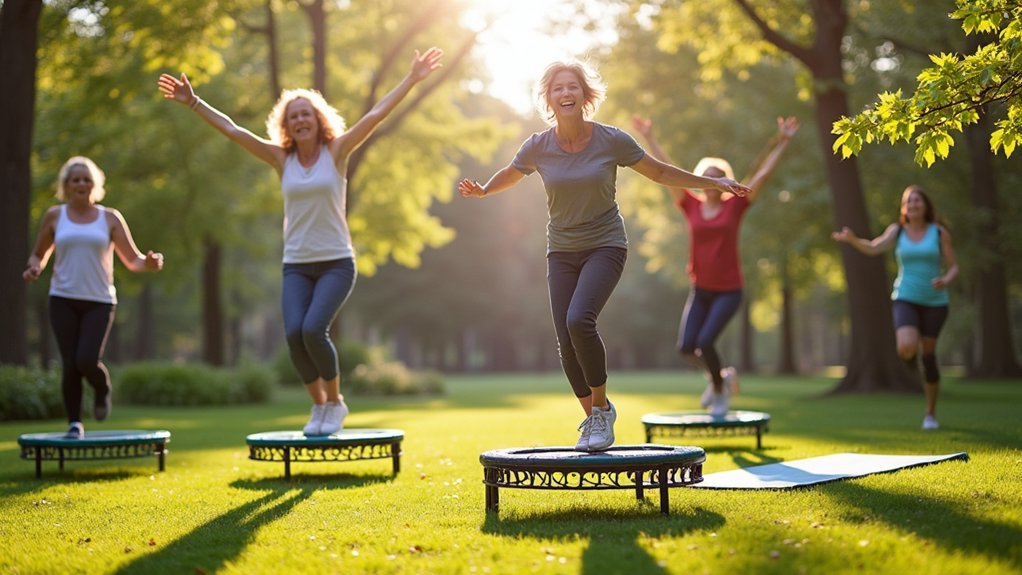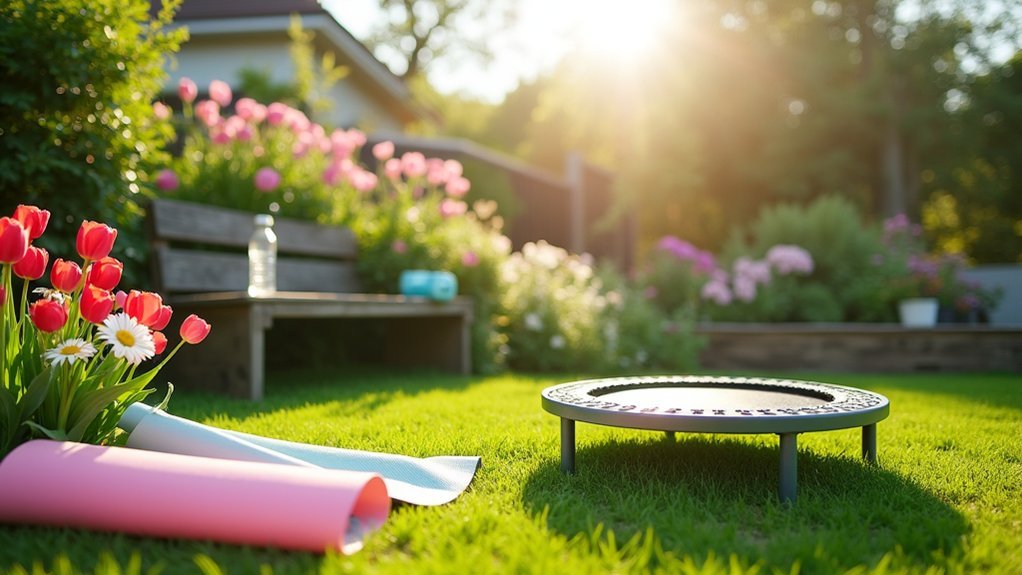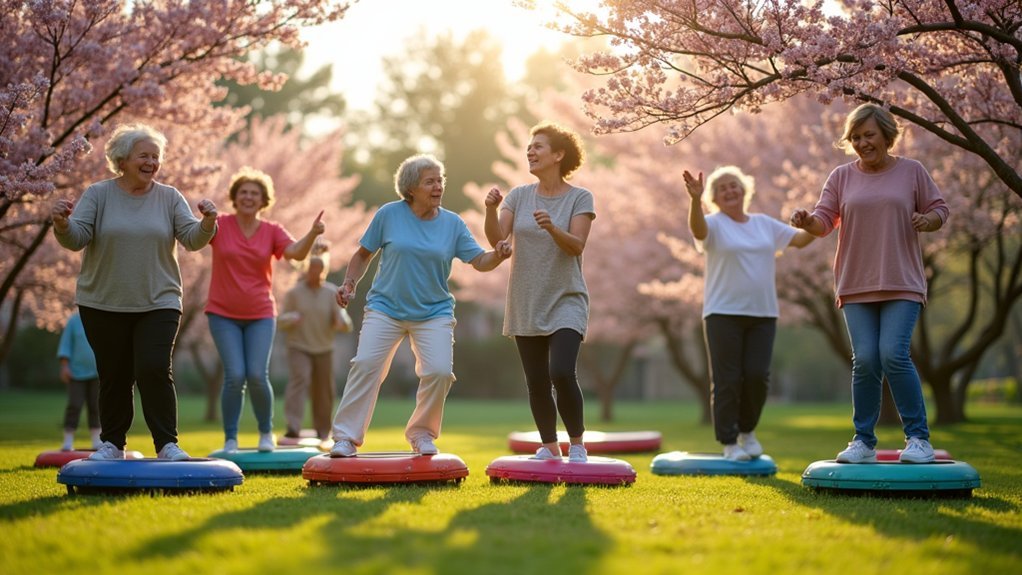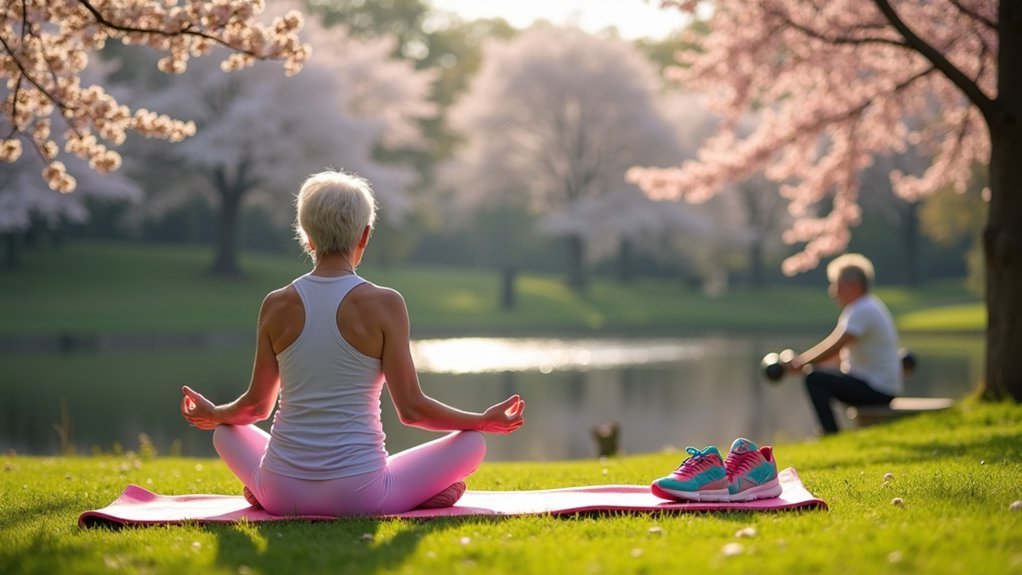Rebounding on a mini trampoline offers an ideal spring workout for the 50+ crowd. You’ll enjoy low-impact exercise that’s gentle on joints while improving balance, cardiovascular health, and lymphatic circulation. Start with 10-20 minute sessions of gentle bouncing, gradually incorporating arm movements and balance exercises. Remember to warm up properly and cool down with targeted stretches. This playful workout not only strengthens your body but lifts your spirits—discover how this bouncy routine can transform your fitness journey.
Why Rebounding Is Perfect for the 50+ Crowd

As we journey into our fifties, finding exercises that energize without punishing our joints becomes essential.
Rebounding offers exactly what your body needs – a low-impact workout that’s gentle on your knees, hips, and spine while delivering impressive cardiovascular benefits.
You’ll notice improvements in balance and coordination after just a few sessions, vital skills that help prevent falls as you age.
Spending just 10-20 minutes daily on a rebounder can lift your mood and reduce anxiety, supporting your mental well-being alongside physical health.
What’s more, rebounding enhances lymphatic circulation, boosting your immune system and aiding detoxification processes that naturally slow with age.
The playful nature of bouncing keeps you coming back, making it easier to maintain consistency in your fitness routine.
Health Benefits of Mini Trampoline Workouts in Spring
Spring’s arrival presents the perfect opportunity to take your rebounding routine to new heights. As you bounce on your mini trampoline, you’re boosting cardiovascular health by improving heart rate and circulation—critical advantages for your 50+ body.
This low impact exercise increases lymphatic circulation by up to 30%, enhancing your immune function just when seasonal changes can challenge your system.
You’ll also develop better balance and coordination, greatly reducing fall risks that become more concerning with age.
If you’re managing arthritis or joint pain, rebounding offers effective resistance training without the harsh impact of traditional exercises.
Plus, those springtime bounces release mood-enhancing endorphins, improving your mental clarity and emotional well-being. Your body and mind will thank you for this gentle yet powerful workout routine.
Getting Started: Choosing the Right Mini Trampoline

Three critical factors should guide your mini trampoline selection when you’re over 50: safety, durability, and comfort. First, verify the weight capacity supports your needs—most quality models handle 200-300 pounds comfortably.
| Feature | Why It Matters |
|---|---|
| Frame Construction | Determines stability during use |
| Weight Capacity | Guarantees safety for your body type |
| Surface Material | Affects joint impact and comfort |
| Size | 36-48″ ideal for indoor workouts |
| Storage Options | Foldable designs save space |
Look for non-slip surfaces and padded edges to prevent accidents while exercising. Adjustable legs provide customization for your height and exercise intensity. If space is limited, consider a foldable mini trampoline that stores easily between sessions. The right trampoline will make your spring workout routine both effective and enjoyable.
Essential Warm-Up Techniques for Safe Rebounding
Before stepping onto your mini trampoline, you’ll need to properly prepare your body with key joint mobilization exercises like “The World’s Greatest Stretch” to counter age-related stiffness.
Start with 3-5 minutes of light cardio at 60-70% effort on a treadmill or cross-trainer to gradually increase your heart rate and warm up your muscles.
You’ll want to adopt a progressive intensity approach, slowly building from gentle bouncing to more vigorous movements while incorporating deep breathing patterns to enhance oxygen flow and prepare your body for the full rebounding workout.
Key Joint Mobilization
Proper joint mobilization stands as the cornerstone of any effective workout routine for those over 50. Before stepping onto your rebounder, spend 3-5 minutes on a treadmill or cross-trainer at 60-70% effort to elevate your heart rate and prepare your body.
Incorporate “The World’s Greatest Stretch” to target multiple muscle groups simultaneously while enhancing flexibility.
“Shin Boxes” and “Thoracic Wall Slides” effectively loosen tight joints, improving your range of motion and greatly reducing injury risk.
While performing these joint mobilization exercises, practice deep breathing—inhale for 7 seconds, exhale for 11. This technique not only relaxes your body but optimizes oxygen flow to your muscles.
Progressive Intensity Approach
While many fitness enthusiasts rush into their rebounding workouts, gradually increasing your intensity protects your joints and maximizes results for those over 50.
Begin with 3-5 minutes of low-impact cardio at 60-70% of your maximum effort. This gentle start elevates your heart rate safely while preparing your muscles for more vigorous activity.
Incorporate deep breathing exercises during this initial phase—inhale for 7 seconds and exhale for 11—to enhance oxygen flow and promote relaxation.
As your body warms, shift to dynamic mobility exercises like “The World’s Greatest Stretch” and “Thoracic Wall Slides” to improve flexibility and range of motion.
Remember to consult your healthcare provider before starting any new exercise routine, especially if you have high blood pressure or other health concerns.
Low-Impact Bouncing Basics for Beginners

A gentle bounce might be just what your spring fitness routine needs. Low-impact bouncing on a mini-trampoline offers excellent cardiovascular benefits while protecting your joints—perfect if you’re over 50 and seeking gentler exercise options.
Start with just 10-20 minutes of basic bouncing exercises to improve muscle tone and coordination. Keep your posture upright and engage your core while performing simple movements.
You’ll not only build strength and balance but also stimulate your lymphatic system, supporting immune function and natural detoxification.
For ideal results, incorporate bouncing sessions 2-3 times weekly into your routine. You’ll notice improved mood, increased energy, and enhanced fitness over time.
These low-impact bouncing basics for beginners provide an enjoyable way to revitalize your fitness journey this spring.
Balance-Enhancing Rebounding Movements
Building on your basic bouncing skills, balance-enhancing rebounding movements offer the next level of challenge for your mini-trampoline workouts.
These exercises specifically target your stabilizing muscles and improve proprioception, vital elements for preventing falls after 50.
Try single-leg bounces, holding for 5-10 seconds before switching sides. This engages your core stability while strengthening lower body muscles. For greater difficulty, add gentle arm movements opposite your standing leg.
Balance improves with each single-leg bounce, creating functional strength that supports everyday movement patterns with minimal joint stress.
You’ll notice these balance-enhancing rebounding movements not only improve coordination but also boost cardiovascular health without stressing your joints. The slight balance adjustments required during each bounce naturally strengthen your abdominal and back muscles.
Practice these movements regularly to enhance mobility and flexibility—essential components for maintaining independence and performing daily activities with confidence.
Upper Body Strengthening on Your Mini Trampoline
Your mini trampoline offers more than just leg and core benefits—it’s an excellent platform for upper body strengthening too.
The slightly unstable surface creates an ideal low-impact environment for resistance exercises while protecting your joints.
Try performing bicep curls, tricep extensions, and shoulder presses while gently bouncing. These movements improve not only your upper body strength but also enhance balance and coordination as you stabilize yourself.
Add arm circles and forearm raises to your routine to increase muscle engagement while boosting cardiovascular health simultaneously.
Research shows these exercises can greatly improve muscle tone in adults over 50, contributing to greater functional fitness and independence.
Start with lighter weights and focus on proper form, gradually increasing resistance as your strength improves.
This approach guarantees both safety and effectiveness in your trampoline workout.
Core-Focused Rebounding Exercises
While many exercise programs neglect core strength, gentle rebounding on your mini trampoline offers an ideal way to strengthen these essential muscles after 50. Start with basic bouncing, focusing on engaging your abdominal muscles as you move. This core-focused approach helps improve your posture and reduces fall risk.
Try seated marches on your rebounder, lifting alternate knees while maintaining a strong center. You’ll strengthen your core while being gentle on your joints. Add arm movements like reaching or pulling to enhance coordination and upper body strength simultaneously.
Just 10-15 minutes of rebounding elevates your heart rate effectively, boosting cardiovascular health without high impact.
You’ll notice improved energy levels and mood with regular sessions, as rebounding releases endorphins and promotes healthy lymphatic circulation.
Lower Body Toning Through Gentle Bouncing
Start with joint-friendly bounce techniques that engage your glutes and thighs without stressing your knees.
You’ll improve balance while bouncing by maintaining a slight bend in your knees and focusing on controlled, gentle movements.
As your strength builds, gradually increase your bounce intensity—adding small variations in height and tempo—to continue challenging your lower body muscles.
Joint-Friendly Bounce Techniques
As spring renews the outdoor landscape, gentle bouncing exercises offer an ideal way to tone your lower body without taxing your joints. Just 10-15 minutes of rebounding on a mini-trampoline can strengthen your legs and glutes while minimizing impact.
These joint-friendly bounce techniques activate your stabilizing muscles, improving balance and coordination—especially important as you age. You’ll notice enhanced joint flexibility and reduced stiffness with regular practice, making everyday movements more comfortable.
When you bounce gently, you’re also stimulating lymphatic circulation, which aids in detoxification and promotes overall wellness during spring.
The beauty of these exercises is their effectiveness without harsh impact. Your body will appreciate the difference compared to traditional workouts, while still building strength in your lower body.
Balance While Bouncing
Finding your balance becomes the cornerstone of effective bouncing exercises for lower body toning. As you practice on a mini-trampoline or rebounder, you’re actively engaging slow-twitch muscle fibers that enhance leg strength without stressing your joints.
Your body’s proprioception—its awareness of position in space—improves with each gentle bounce. This heightened sense of balance particularly benefits you after 50, when coordination naturally begins to change.
For maximum benefit, set a timer for 10-15 minutes, 2-3 times weekly. During these sessions, your lymphatic system gets a gentle boost, supporting detoxification and immune function.
You’ll notice improved stability in everyday movements as your core and leg muscles strengthen together. The beauty of bouncing lies in its accessibility—you’ll tone your lower body while actually enjoying the process.
Progressive Bounce Intensity
While beginning your bouncing journey, mastering progressive intensity becomes your secret weapon for lower body transformation. Start with gentle, low-impact bounces that respect your joints while activating your leg and glute muscles.
As your comfort grows, gradually increase both height and speed of your bounces. This progressive bounce intensity approach builds strength safely without risking injury.
Try incorporating rhythmic movements like mini squats or calf raises into your routine for just 5-10 minutes daily. You’ll notice improved circulation almost immediately, while the long-term benefits include enhanced mobility and stability—crucial advantages as you age.
Your lower body will become noticeably stronger, making everyday activities feel easier and more enjoyable. Remember, consistency trumps intensity—regular gentle bouncing delivers remarkable results without stressing your body.
Cardio Intervals for Improved Heart Health
When you reach your 50s, your heart requires special attention to maintain its vigor and efficiency. Incorporating cardio intervals into your spring routine can greatly boost your cardiovascular health with minimal time investment. By alternating between fast walking and moderate-paced toning exercises for just 15-20 minutes twice weekly, you’ll lower your risk of heart disease.
| Interval Type | Duration | Intensity |
|---|---|---|
| Warm-up | 3 min | Low |
| Fast walking | 1 min | Moderate-high |
| Recovery | 2 min | Low |
| Repeat cycle | 3-4 times | Varied |
These short bursts of higher intensity followed by recovery periods enhance your cardiovascular endurance and metabolic function. You’ll also experience improved blood pressure, better cholesterol levels, and easier weight management—all critical for maintaining an active lifestyle as you age.
Cool-Down Stretches After Your Rebounding Session
After your energetic bounces on the mini-trampoline, you’ll need a proper stretch-and-breathe sequence to signal your body it’s time to recover.
Focus on gentle neck rolls, shoulder stretches, and hip openers while breathing deeply—inhaling for 7 seconds and exhaling for 11 seconds—to relax your muscles completely.
These movements specifically target joints that absorb impact during rebounding, giving particular attention to ankles, knees, and hips to maintain your mobility and prevent stiffness as you age.
Stretch-and-Breathe Sequence
Your body deserves a gentle shift from activity to rest, which is why the Stretch-and-Breathe sequence forms an essential part of your rebounding workout. This relaxing cool-down minimizes post-workout aches while promoting recovery through mindful movement.
Incorporate these essential elements into your stretch-and-breathe sequence:
- Begin with gentle neck and shoulder stretches, holding your head in your hand and pulling slightly to the side to release built-up tension.
- Support yourself with a chair for seated twists that enhance spinal mobility while engaging your core.
- Focus on hip flexibility by crossing your legs and leaning forward with a straight back.
- Finish with full-body stretches, maintaining proper posture as you reach forward and include knee stretches to completely relax your leg muscles.
Joint Recovery Focus
While rebounding offers excellent low-impact cardiovascular benefits, proper post-workout care remains essential for joint health, especially after 50.
Your joint recovery focus should include gentle static stretches targeting major muscle groups used during your bounce session.
Try seated stretches with crossed legs while leaning forward, maintaining a straight back for ideal spinal alignment.
For upper body relief, perform neck and shoulder stretches by gently holding your head and applying slight side pressure to release accumulated tension.
Don’t neglect your hips and legs—cross-legged forward bends effectively promote flexibility in these areas.
Remember to breathe deeply throughout your cool-down routine, as this facilitates relaxation and enhances recovery.
These simple post-rebounding practices will safeguard your joints while maximizing the benefits of your springy workout regimen.
Creating a Sustainable Weekly Rebounding Routine
Since consistency forms the foundation of any effective exercise program, establishing a well-structured rebounding routine can help you maintain momentum throughout spring and beyond.
Consistent rebounding workouts create sustainable momentum, transforming spring fitness goals into year-round healthy habits.
Aim for 2-3 sessions per week on non-consecutive days, allowing your body adequate recovery time—especially if you’re new to rebounding.
Start with 10-15 minute sessions, gradually working up to 20-30 minutes as your stamina improves. Always include warm-up mobility exercises and post-workout stretching to enhance flexibility and minimize soreness.
- Track your progress – Note session duration and movement complexity to celebrate improvements
- Mix your movements – Combine gentle bouncing with arm movements to engage multiple muscle groups
- Listen to your body – Adjust intensity based on how you feel each day
- Stay patient – Consistency matters more than intensity in building lasting fitness habits
Tracking Your Progress and Celebrating Achievements
Meaningful progress often remains invisible without proper documentation, making a fitness journal your most valuable companion on this spring fitness journey. Record weights, repetitions, and notes about how you felt during each session to effectively assess improvements over time.
Consider using fitness apps or wearable devices to visualize your activity levels, heart rate, and calories burned across weeks and months. These tools make tracking your progress tangible and motivating.
Set specific monthly goals—whether completing a certain number of workouts or increasing weights by small increments—and review your achievements every 4-6 weeks.
Don’t overlook small victories; celebrating that extra repetition or slight weight increase reinforces a positive mindset toward fitness.
Adjust your routine as needed to maintain challenge while acknowledging how far you’ve come.
Frequently Asked Questions
What Is the Workout Routine for a 50 Year Old?
You’ll benefit from strength training 2-3 times weekly, focusing on full-body exercises for your legs, chest, back, and shoulders. Include warm-ups, core work, 15-20 minutes of cardio twice weekly, and post-workout stretching.
What Is the 3-3-3 Rule Gym?
The 3-3-3 rule means you’ll perform three sets of three exercises for three repetitions each. It’s a structured approach that helps you develop balanced muscle strength while maintaining proper form throughout your workout.
How Many Times a Week Should a 50 Year Old Workout?
You should aim for 2-3 full-body workouts per week if you’re 50 or older. Don’t forget to allow 1-2 rest days between sessions for proper recovery, as your body needs time to heal and strengthen.
What Is the Best Form of Exercise for Over 50?
You’ll benefit most from a mix of low-impact cardio (walking, swimming, cycling), strength training twice weekly, and flexibility exercises like yoga. Always choose activities you enjoy, as consistency matters more than exercise type.
In Summary
You’ve got all the tools you need to spring into a healthier you! By adding rebounding to your routine, you’re strengthening your body, boosting your heart health, and having fun along the way. Start slow, be consistent, and watch how your balance and energy improve. Remember, it’s not about perfection but progress. Your 50+ body will thank you for this gentle, effective workout choice.





Leave a Reply